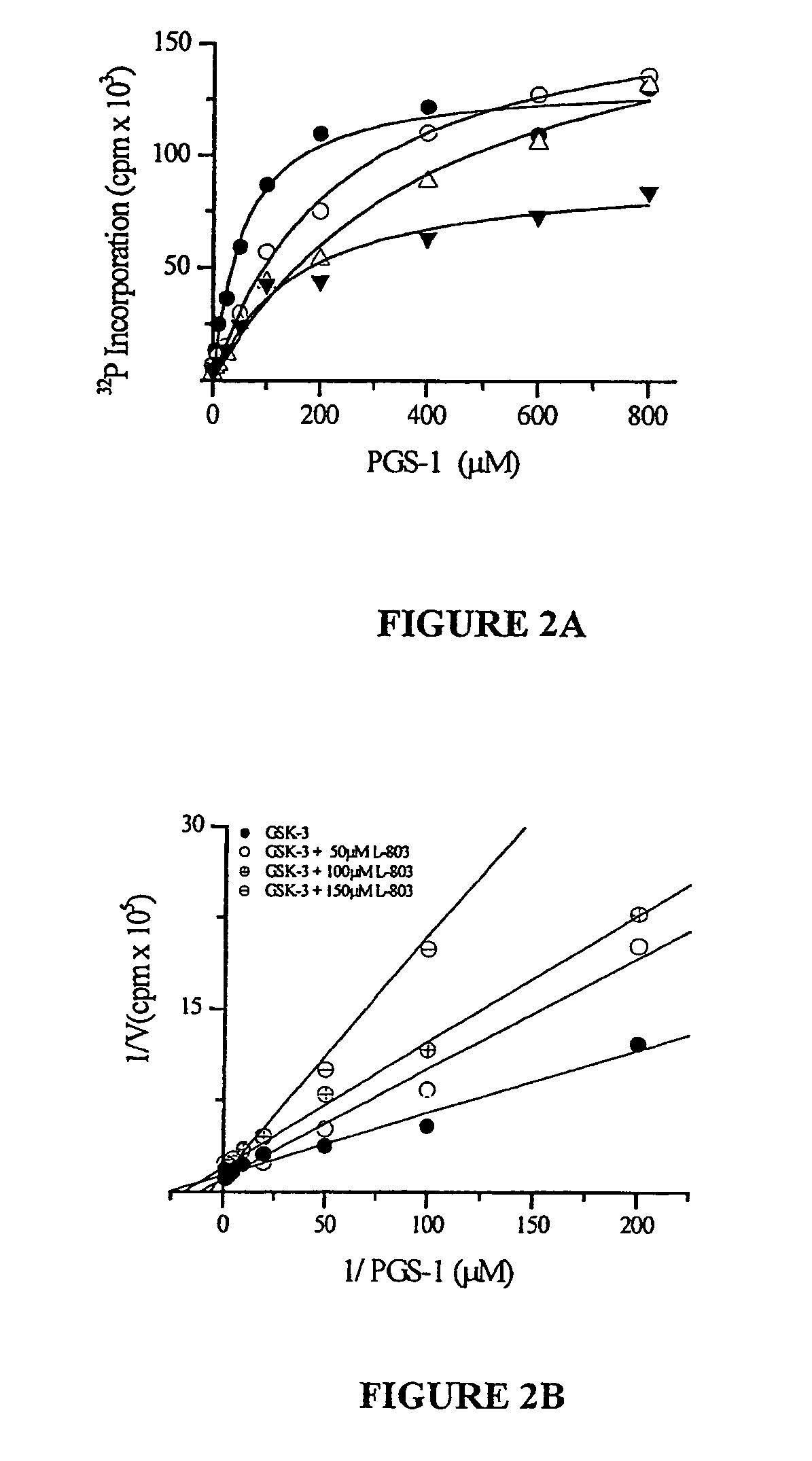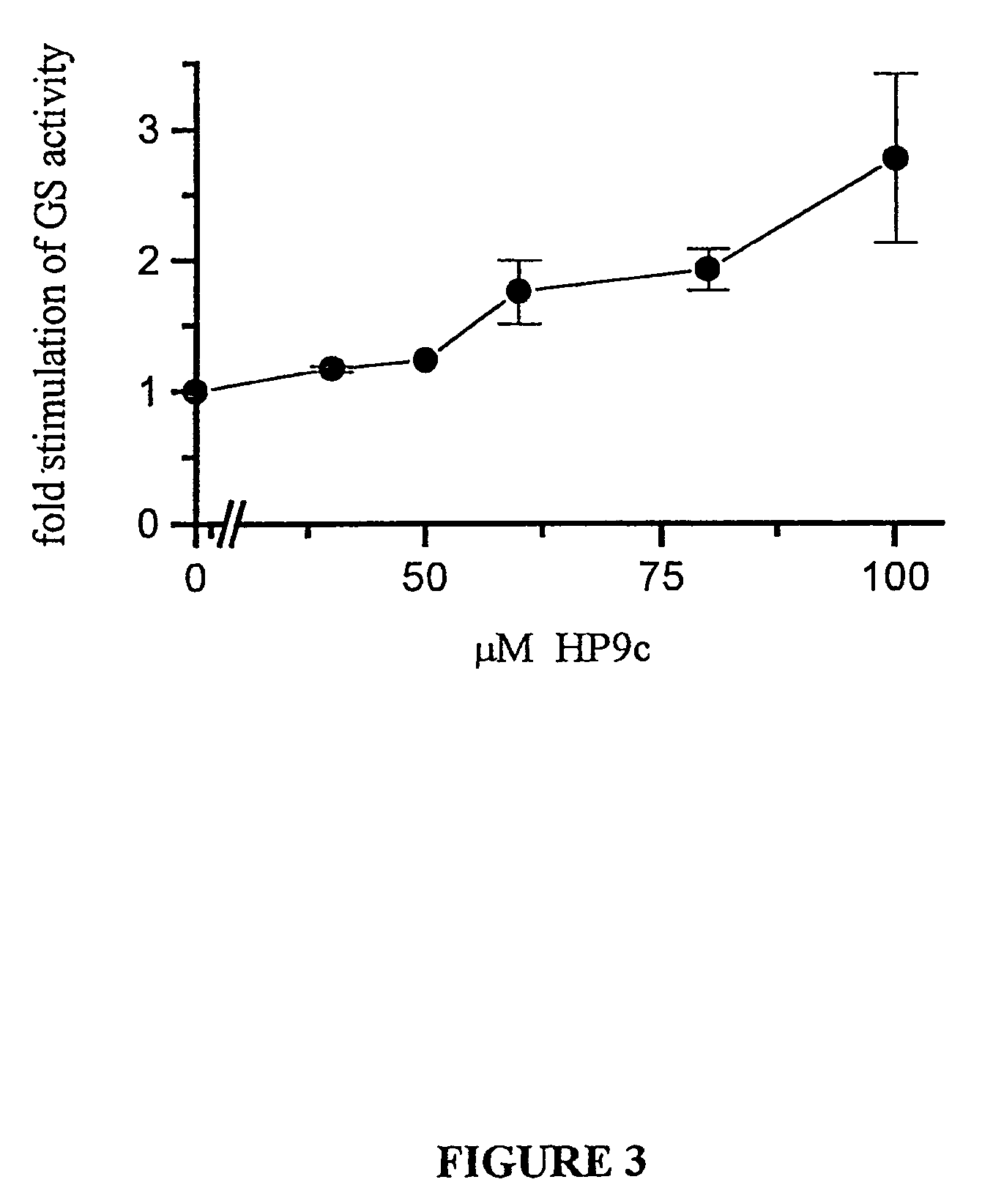Glycogen synthase kinase-3 inhibitors
a glycogen synthase and inhibitor technology, applied in the field of new peptide inhibitors of glycogen synthase kinase, can solve the problems of only nominal inhibition of gsk-3 activity by the substrate, cell death, major drawback of most other therapeutics, etc., and achieves high affinity, inhibits the catalytic activity of gsk-3, and high efficacy and specificity
- Summary
- Abstract
- Description
- Claims
- Application Information
AI Technical Summary
Problems solved by technology
Method used
Image
Examples
example 1
Synthesis of a GSK-3 Peptide Inhibitor
[0138]Small, synthetic peptide inhibitors, which are highly specific for GSK-3, were synthesized as described below. The peptides were synthesized according to standard methodologies. Table 1 summarizes the peptides that were synthesized and tested for their ability to inhibit GSK-3. The peptides were patterned after two known substrates of GSK-3, CREB (cAMP response element binding protein) (Fiol et al, 1994), and heat shock factor-1 (HSF-1) (Chu et al, 1996). As illustrated in peptide #1, two serine sites are important in the recognition process, a phosphorylated serine (2) and the serine phosphorylated by the enzyme (1), the two serine being separated by 3 amino acids. This recognition process is also demonstrated in peptide #3 (p9CREB), which is the same as peptide #1 shortened to 9 amino acids, which peptide is also a good substrate of GSK-3 (see Eldar-Finkelman et al, 1997; and Hallstrom et al, 1998). The presence of phosphorylated serine ...
example 2
Selective Inhibition of GSK-3 by a Peptide Inhibitor
[0140]Inhibition of Substrate Phosphorylation Activity of GSK-3
[0141]The inhibition of GSK-3 activity by a small, synthetic peptide inhibitor synthesized as described above in Example 1, was tested by in vitro kinase assay. Peptide inhibitor #5 (see Table 1) is a 13 amino acid synthetic peptide having the sequence KRREILARRPS(p)YR (SEQ ID NO:5), where S(p)=phosphoserine, and A represents the Ser to Ala substitution at the GSK-3 phosphorylation site.
[0142]Inhibition of GSK-3 by the peptide inhibitor #5 was determined by performing in vitro kinase assays of GSK-3 with a peptide substrate and determination of 32P incorporation into the substrate. In vitro kinase assays were performed utilizing purified recombinant rabbit GSK-3 using the method of Eldar-Finkelman et al (1997), a peptide substrate PGS-1 peptide (see Hallstrom et al, 1998), various concentrations of the peptide inhibitor, and 32P-γATP. The assay mixture contained: 0.5 μl...
example 3
The Effect of Peptide Inhibitor of Glycogen Synthase in Intact Cells
[0145]The present inventor examined whether the peptide inhibitors are capable of inhibiting GSK-3 activity in intact cells. There is a substantial evidence that insulin-activation of glycogen synthase (GS) is via inhibition of GSK-3. Peptide #5 was, therefore, tested to see if it enhanced GS activity in intact cells. In order to improve the delivery of the peptide into cells, synthesized peptide #5 was linked to a hydrophobic cell permeable peptide (16 amino acids; Hawiger, 1997), termed here HP9c. 293 cells were treated with increased concentrations of HP9c, and GS activity was measured as previously described (Eldar-Finkelman et al, 1996). Treatment of cells with the peptides resulted in increased basal GS activity. The effective peptide concentrations ranged between 60-100 μM (FIG. 3).
[0146]Phosphorylation of GS by GSK-3 also enhances GS sensitivity to its allosteric regulator glucose 6 phosphate (G6P). This ef...
PUM
 Login to View More
Login to View More Abstract
Description
Claims
Application Information
 Login to View More
Login to View More - R&D
- Intellectual Property
- Life Sciences
- Materials
- Tech Scout
- Unparalleled Data Quality
- Higher Quality Content
- 60% Fewer Hallucinations
Browse by: Latest US Patents, China's latest patents, Technical Efficacy Thesaurus, Application Domain, Technology Topic, Popular Technical Reports.
© 2025 PatSnap. All rights reserved.Legal|Privacy policy|Modern Slavery Act Transparency Statement|Sitemap|About US| Contact US: help@patsnap.com



